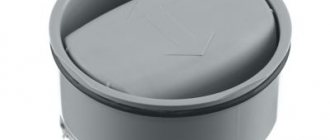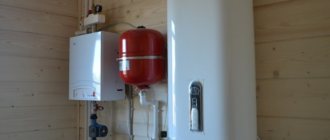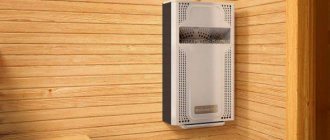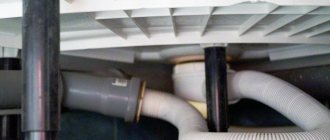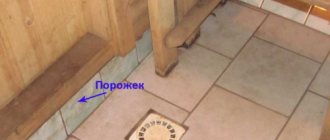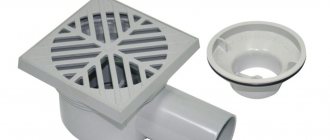SHARE ON SOCIAL NETWORKS
FacebookTwitterOkGoogle+PinterestVk
A water seal for sewerage is a mandatory element of plumbing equipment. It serves to prevent the entry of strong unpleasant odors into the room from the waste system. What is the operating principle of the device, what types of hydraulic valves are there, how to choose the right product and install it? All answers are contained in this article.
The sewer water seal is used to prevent the penetration of unpleasant odors into the room from the sewage system
Water seal: this is a mandatory element of plumbing equipment
The first step is to understand what a shutter is. The element is represented by a pipe with bends, which has a certain shape. It can be additionally equipped with dynamic or dead-end devices. There is a permanent water plug in the lower elbow of the siphon, which, if the system is not used for a long time, can evaporate, which will lead to the penetration of unpleasant odors from the sewer network into the room.
For the water seal to work correctly, there must always be water in its cavity.
With active use of plumbing equipment, the supply of liquid is constantly renewed, successfully containing foul-smelling substances. When drained, wastewater flows freely through the siphon, which eliminates the possibility of clogging the system.
Important! For the water seal to function correctly, a certain volume of water must be located in its cavity, which is necessary to prevent gas backflow and unpleasant odors.
Why do you need a water seal? The siphon blocks hydraulic shocks, which significantly reduces the load on sewer pipes and devices. It also protects living spaces from the penetration of unpleasant odors from the waste system.
A hydraulic valve is rarely found inside a specific plumbing fixture such as a toilet or urinal. Mostly it is mounted to a fixture. A washbasin, bathtub, shower or toilet without a water seal is not installed in a residential building.
The hydraulic valve can be inside the plumbing fixture, but it is preferably mounted separately
How does a siphon work and on what principle does it work?
Wherever this device is located, its purpose is always the same:
- compensation of hydraulic shocks to limit loads on the gravity sewage system;
- preventing foul-smelling air from entering the living space from the drain system.
If the hydraulic valve is selected correctly and installed in accordance with the requirements for it, clean air is maintained in the room, and the sewage system works for a long time without failures. This can be achieved by knowing what a water seal in a sewer is and using it correctly.
The designs of closing devices are different, but, in general, it is a product made of pipes, in the bend of which water is stored, blocking the lumen along the inner diameter.
The water plug is constantly inside the pipe, periodically renewed. During a long break, the liquid in the hydraulic seals gradually dries out, allowing the smell to enter the room. This phenomenon is typical for buildings that are periodically visited, for example, country houses.
All elements of the sewer system are interconnected. For example, a drain pipe prevents “siphon failure”—the drawing of water into the riser during descent by equalizing the pressure in the sewer pipe. Air valves of various designs are also used for the same purpose - see installation features, types and manufacturers. They are used when there are no vent pipes in the building structure.
Types of hydraulic valves depending on design
Depending on the design features, there are 6 types of water seals: cranked, bottle, double-turn, corrugated, dry and with an overflow system.
An elbowed siphon with a water seal is easy to recognize by its appearance. Its design resembles the Latin letter U. The siphon is made of plastic or metal. The first option is represented by products made of polypropylene, which are characterized by reliability, simplicity and ease of installation. For the manufacture of metal siphons, cast iron or bronze is used. Today, such models are less common, which is due to their high cost.
Plastic devices can be produced in a disposable design; they do not have the ability to adjust the position of the element. In case of failure, the product is completely dismantled. Other models consist of components that can move and rotate to adjust the position of the nozzle. The parts are fixed using overhead plastic nuts and clamps.
The elbow has two bends: inlet and outlet. The lower position of the second element is 5-6 cm below the first. More reliable and durable options are represented by the S-shaped design. Cleaning the product is carried out using a special flexible cable with a brush at the end or manually after disassembling the product.
The elbow water seal for sewerage has a U- or S-shaped design
This sewer water seal is characterized by durability, which ensures free and easy installation of the system without fear of damage. Elbowed siphons are mainly installed on sinks, bathtubs and toilets. There are models equipped with an additional outlet, which makes it possible to simultaneously use the water seal for the washing machine.
When to use a water seal in a bath
In a bathhouse, you need to use a water seal for the sewer if the water drains into the general drainage system. If the water is drained outside the bathhouse into a pit, from where it is absorbed, there cannot be any smell in this case.
If the bathhouse sewerage system is connected to a common system, you can use ready-made siphons (as for a bathtub or washbasin) of any design. Plastic or metal bottle-type closures or corrugated hose closures are available for sale.
Bottle type sewer seal
Sometimes you can still find a cast iron water seal, but their production stopped several years ago, and they are found mainly in old houses.
Water seal for plastic sewerage
CENTER AQUAPA water seals are available for sale, which are inserted into a plastic pipe with a diameter of 55 mm or 110 mm.
The CENTER AQUAPA water seal is inserted into a pipe with a diameter of 110 mm
In essence, the water seal consists of two glasses inserted into one another.
Upper and lower parts of the CENTER AQUAPA water seal
After pouring the floors in the bathhouse, the top of the water seal should be in a small recess to completely drain the water.
The upper part of the water seal is at the level of the lowest point
This water seal has two advantages:
- It additionally serves as a settling tank;
- Even if the water freezes in the water seal, it will not be damaged.
How to make a water seal with your own hands
You can make a water seal with your own hands quite easily. To do this, a piece of pipe of suitable diameter must be bent in the shape of the letter “U” and welded (connected using couplings) to the pipe after the drain funnel (the height of the water seal is usually 50-70 mm). It is advisable to do this while laying the foundation and arranging the floors, but if the bathhouse is already functioning and the smell bothers you, you can try to eliminate this nuisance.
If the foundation is columnar and PVC sewer pipes are accessible, this makes things easier. Under the bathhouse, you can weld the required piece of pipe to the drain pipe. If there is no access to the pipes, you will have to organize it: dismantle part of the floor if it is wooden, or cut it out with a grinder if it is concrete. Then connect a bended pipe to the sewer using couplings or welding.
It is necessary to take into account that water evaporates from any water seal. And if you do not use the sewer for a long time, after 40-50 days it will completely dry out, and gases from the sewer will freely penetrate into the room.
Distinctive features of bottle hydraulic valves
Bottle devices are most often installed in kitchens under sinks. To understand how a water seal works, you should study its design. The product is designed in such a way that food waste particles are retained, preventing clogging of the system in order to maintain its good performance. At the same time, such a shutter performs the main function, which is to retain unpleasant odors and eliminate the possibility of them entering the room.
A bottle water seal consists of pipes and an additional element in the shape of a bottle, which is a kind of container for collecting food waste. This container is located below the level of the drain pipe, this provides free access to the element. The container includes a vertical drain pipe connected to the sink, and a pipe for connection to the sewer network comes out of its side.
Bottle siphons are made of polypropylene, but in terms of strength they are inferior to their knee counterparts. This is due to the fact that the connection of all elements may not withstand strong water pressure. However, the bottle siphon is most suitable for use in the kitchen. A positive point also lies in the lower price of a water seal for 110 mm sewerage, which averages 250 rubles.
Due to its structure, the bottle water seal is most suitable for use in the kitchen
For normal operation of the device, it must be periodically cleaned, since food waste residues accumulate in the cavity of the container, preventing the free flow of drain water. To clean the container, it must be removed. To do this, unscrew the cover nut and shake out all the debris from the container. Then you should thoroughly wash the inside of the container using detergents and hot water. After this, the device is installed in its original place. The nut is tightened tightly to prevent water leakage.
Important! Bottle water seals are capable of trapping an object that accidentally falls into the drain.
Choosing the right check valve
When you need to install a check valve in the sewer, you will have to rely only on your own knowledge. There are professional tips that provide all the necessary information to avoid making mistakes. What subtleties need to be taken into account?
Valve material depends on the system itself
Stainless steel cannot be connected to a plastic structure, since this will require the use of an adapter. When choosing a type, you should pay attention to the volume of wastewater. If they are large, a ball or lift type may be more suitable. For household systems, it is better to choose a reed valve, whose installation will take a minimum of time. The wafer is usually mounted only on a 50 mm pipe, provided that there is no large waste in the drain water. If the operation is assessed, it is necessary to note the possibility of removing the blockage after installation without disassembling the structure.
These points will tell you how to assemble a complete sewer system. Now for this you will be able to use ready-made elements that are more reminiscent of a constructor
Moreover, even complex devices can be easily connected to the pipe, without requiring additional actions, which is important for every inexperienced owner
If the question remains about the advisability of installing a check valve, the possibility of overflowing the septic tank should be noted. In a private house, this will lead to the movement of drain water in the opposite direction. Professionals say that it is impossible to do without additional elements when you want to maintain comfort in your home.
Do-it-yourself sewerage is not a difficult task. Manufacturers offer various elements that are freely interconnected. The main thing to remember is that the check valve is an essential part of the design. Without it, it is impossible to correctly work out minor details. Such errors lead to erroneous circuits, especially when the device is closed from permanent access. After this, removing blockages becomes problematic, making it impossible to do this without a lengthy check of the entire system.
What is a double-turn water seal for a bathroom?
A double-turn siphon is an analogue of a knee outlet, but differs in a more complex water seal design. The drain pipe of the device is connected to the outlet pipe of the plumbing equipment. A filter grid is additionally installed in this place to trap hair and animal fur. It smoothly passes into an elbow that connects to another pipe, which is directed to the drain. The last element is located at a slight slope.
How to use the water seal when cleaning it? To do this, some models of double-turn siphons can additionally be equipped with inspection holes, which are tightly closed with plugs, which makes it possible to inspect and clean the water seal cavity from contaminants. They are located at the bottom of the device. The function of the hole can be performed by a removable fragment of the knee located in the upper part of the device.
A double-turn water seal for a bathroom is similar to a cranked one, but is a more complex device
Important! Double-turn valves are mainly installed in bathrooms.
Double-turn siphons are made of polypropylene. More expensive luxury models can be made of brass with a chrome-plated surface. When installing such products, you will need a special tool equipped with soft jaws, which will eliminate the possibility of damage to the mirror surface of the device.
Bottle-type hydraulic valves are characterized by strength, reliability and long-term operation. The design is easily adjustable thanks to movable components. It is easy to install and can be installed even in narrow spaces.
What it is?
The fermentation process is carried out thanks to the vital activity of yeast.
These active microorganisms, feeding on sugar, produce alcohol and carbon dioxide as a byproduct. Our task is to preserve the alcohol and get rid of carbon dioxide. If you simply open the fermentation container, the gas will of course evaporate, but oxygen will enter the mash. It will become a catalyst for temporarily inactive bacteria inhabiting the mash. By reacting with oxygen, they convert the alcohol into acetic acid. To prevent souring, it is customary to close the mash tightly. But the amount of gas released is so great that the bottle will explode under its pressure already at the beginning of fermentation. That's what a water seal is used for.
The operating principle and name were borrowed from plumbing siphons. Initially, a water seal is a system of tubes (hoses, containers), the cross-section of which at the outlet is completely blocked by water. In this case, the water barrier does not prevent gas from escaping from the mash, but does not allow oxygen to enter. The already simple design is constantly modernized by experienced moonshiners. Therefore, a great variety of types of homemade water seals for homemade wine and mash have appeared. By the way, using water is not always necessary.
Advantages and disadvantages of corrugated hydraulic valves
The corrugated type of siphon is represented by a polypropylene modification, which is durable, flexible and can be installed when installing sewerage systems in small spaces. Due to its plasticity, such a pipe can be located in places where other types of siphon cannot be placed. This is the simplest option, which contains a minimum number of elements that do not require assembly.
The corrugated hydraulic valve is the simplest option with the fewest elements
The corrugated siphon can be rotated at any angle and directed in the desired direction. This do-it-yourself version of a water seal for sewerage is often installed under the bathtub, since the model easily fits in a cramped space between the floor and the bottom of the container. One end of the water seal is connected to the drain hole, and the other to the sewer pipe. Using corrugation, you can also organize a drain with a water seal in the bathhouse of a private house.
Despite many advantages, the corrugated siphon has a single, but significant drawback. The surface of the pipe has ribbed walls on which debris in the form of hair, soap, sand and other dirt accumulates. When installing such a siphon, you should install a filter with a fine-mesh grid.
Important! If a bellows gate is not cleaned for a long period of time, it may lose its strength and elasticity due to excess weight in the form of dirt.
When operating a corrugated water seal, its condition should be monitored. The formation of sag causes debris to accumulate. The folds will quickly begin to wear out, crack and let water through.
If the corrugated water seal is not cleaned, it may lose its elasticity and strength.
Double turn
According to the principle of operation and shape, such sewer water seals resemble knee seals, but differ from them in that they have not 1, but 2 bends. The pipes from which they are made have a special shape that allows them to avoid blockages and at the same time withstand extreme pressure loads and shocks
Such properties have made it possible to widely use double-turn siphons in industrial enterprises, where it is important to continuously remove large volumes of water. The design is also perfectly protected from leaks
It is adjustable, which allows it to be installed in any, even very narrow places.
Bottle siphons are easier to maintain than double-turn siphons, but it is the latter that provide a high degree of operational reliability, which in some cases is irreplaceable.
Corrugated
They are polypropylene pipes with a flexible folded structure. One end of a siphon of this type is attached to the drain of a plumbing fixture, and the other to the entrance to the sewer. Between these points, the tube itself can be bent and positioned in a large number of options, which makes corrugated water seals the only ones applicable in small apartments.
By placing the device as required by the space under the bathtub or sink, you can equip even the most modest room. This type of sewer siphon is easy to install. The disadvantages are relatively rapid wear and formation of blockages. They arise due to the fact that hard particles - hair, food, pieces of soap, etc. - accumulate on a folded surface faster than on a smooth surface. If the owners notice that the tube is sagging, it should be replaced as soon as possible.
Siphons with overflows
This is a separate type of water seal for sewerage, which provides for the presence of an additional drain hole in the plumbing. They do it in order to prevent water from pouring out of the bathtub or sink onto the floor if for some reason it suddenly stops flowing into the main drain hole. When using a siphon with an overflow, its main pipe is mounted as usual, and the additional one is connected to the overflow hole.
Water seals of this type are popular because of their safety. However, they also have a drawback. This is the possibility of excess water being poured out while taking a bath or washing. The owner may incur additional financial costs to pay for utilities.
If you are planning to install a siphon with overflow, you should choose the right model. Those who have enough space can afford to install the most reliable metal siphon. And those whose homes have little space will benefit from purchasing compact and flexible plastic models.
Another important nuance is the choice of overflow according to its throughput. If it turns out to be too small than required by the amount of water in the bath, then the consequences of using such a siphon can even be dangerous. Data on the technical parameters of each siphon should be immediately found out when examining it in the store. Buying the wrong part will be a useless and unpleasant waste of money.
Characteristic features of the overflow system
Another type of product is a hydraulic siphon with a water seal for a sink or sink, equipped with an overflow system. The device is equipped with an additional pipe, which eliminates the possibility of flooding of the apartment if it is impossible for water to drain into the sewer. This pipe is inserted into a hole specially created for it, which is located in the upper part of the sink or sink.
This siphon prevents flooding, but increases water consumption. If the tap is turned on and the drain is closed, water will flow through the overflow pipe into the sewer when it reaches a certain level. A water seal with an overflow system can be installed in the kitchen or bathroom.
Hydraulic valves with an overflow system are made of plastic or metal. Plastic products have a lower cost and are very flexible. Brass-bronze siphons are characterized by strength, durability, complexity of installation and high cost.
Important! When choosing a siphon with an overflow, you should pay attention to the throughput of the pipe so that the device will work efficiently in the future.
The water seal for a sink or sink is equipped with an overflow system - an additional pipe, thanks to which the possibility of flooding of the apartment is eliminated
Why is it needed and where is it used?
A water seal is needed to prevent the penetration of gas from sewer pipes into the rooms where devices connected to the sewer are located. The same problem can be solved by a household pneumatic valve installed in the drain network.
Its operating principle is based on mechanically blocking the sewerage section with plugs.
If solids become trapped between the wall and the plug, the valve's performance will be reduced. In contrast, a water plug in the siphon will, under any circumstances, completely block the drain hole into the sewer.
Installing a siphon with a water seal not only performs a protective function, but also solves additional problems:
- reduces the sound volume during drainage;
- serves as a sump - large particles of debris settle at the bottom of the siphon;
- prevents bacteria and insects from entering living spaces through the sewer system.
Water protection is used in all plumbing fixtures. Water seals for sewerage are installed in the bathhouse, as well as in the bathtub and shower. The toilet is the only device that does not require connecting a water seal. Its design involves the use of a built-in siphon to remove waste.
What is a dry siphon for sewerage
The operating principle and design of a dry water seal for sewage differ from previous analogues. A non-return valve is installed in the threaded drain pipe, which prevents the return flow of water and the entry of unpleasant odors from the sewer system into the room.
Important! It is advisable to install such water seals exclusively in shower stalls, and in kitchen sinks they can cause permanent blockages.
The dry water seal for the shower stall is available in several varieties. In the membrane version, the hole is closed at the moment of liquid outflow using an elastic silicone membrane in the form of a short sleeve. Pendulum siphons, thanks to curtains, provide quick blocking of access to the hole.
Float models operate on the principle of a flush tank. The design is an inverted light glass, the edges of which are immersed in water. A light float is located on the surface of the water. After draining it, lowering itself, it blocks the drain. In some models, instead of a float, a light ball is installed, which, after the liquid has flowed out, is lowered into the outer seat, ensuring a hermetically sealed closure of the drain hole. This option can be made independently when arranging the sewer distribution in the bathhouse.
It is advisable to install a dry siphon for sewerage only in shower stalls
Important! If the sewer lines dry out during a period when they are not in use, the dry seal will prevent the unpleasant odor from entering the room.
Dry shutter
A modern dry hydraulic seal for sewage is noticeably different in design from its hydraulic counterparts. It is recommended to install such devices on the lower floors of multi-story buildings, as well as when plumbing fixtures are rarely used.
“Dry” membrane-type valves are closed by an elastic membrane after the water has drained, and pendulum models close instantly in the absence of liquid. Float valves function similarly to cistern flush fittings.
Types
Dry seals are available in several versions, each of them has its own characteristics. Here are the most common options:
- Membrane. This is the simplest and most common option. The valve operates due to a spring membrane, which opens when water flows from the drain hole, but remains closed until the water is used.
- Float This option can be called transitional between dry and water seals. The device is equipped with a float valve. When liquid enters, the float floats up so as not to interfere with the liquid leaving. And after the water leaves, the float falls into place, sealing the lumen of the sewer pipe.
- Pendulum. The valve in such a valve has a single attachment point. When water enters the drain, the pendulum deviates, opening the passage. Then, under the influence of gravity, the valve returns to its place.
- With molecular memory. This is a high-tech option; such shutters are quite expensive. Thanks to new technologies, membrane elements reliably seal the pipe lumen after water stops flowing into the drain.
So, there are different options for water seals for sewerage. The choice of option is made depending on the type of plumbing element, as well as operating conditions. Installation of water seals is a prerequisite for assembling an internal sewerage system. If they are missing or installed incorrectly, an unpleasant sewer smell will certainly appear in the apartment.
Pros of the option
Advantage of the option:
- the device does not require water supply for normal operation;
- the model can be installed even in unheated rooms, since there is no threat of destruction due to freezing water. This option is suitable, for example, for a summer cottage that is not used during the cold season;
- dry siphons are compact and convenient;
- it is much more difficult to break a dry seal than a water seal;
- eliminate the backflow of dirty water, which can occur when a blockage forms;
- the shutter can be installed both vertically and horizontally;
- water does not stagnate in the shutter, in which harmful bacterial flora can develop;
- has excellent sound insulation;
- has a long service life.
Characteristic features of a sewer drain with a water seal
When drainage is carried out from the entire surface of the floor, a sewer drain with a water seal is installed. It is mounted in the central part of the floor with a slight slope at the time of construction of the shower stall.
A drain for a shower with a water seal consists of a receiving funnel, a siphon with a removable grate and an outlet with a coupling. The first element is designed to receive water and discharge it into the sewer. It is securely attached to the floor surface.
Related article:
Sink siphon with overflow. Subtleties of selection and installation
Types of siphons. Nuances when choosing siphons for a sink with overflow. Complete set of products, features of correct installation.
The tightness of the connection is ensured using a waterproofing membrane. Next, the water enters the siphon, which is represented by a small-volume chamber, passing through the upper filter grid and pipe. Then the drain, overflowing through the outlet openings or edges of the container, moves along the outlet pipe connected to the sewer pipe.
A sewer drain with a water seal consists of a siphon with a removable grate, a receiving funnel and an outlet
In terms of design, such a mechanism resembles a bottle-type device. However, the shower tray siphon with a water seal does not have a removable bottom cover, which is used to remove debris. This is due to the fact that the siphon body is hidden in the floor screed. All debris is collected in the inner cup, which can be easily removed from the body and cleaned with detergent.
Design and material for the manufacture of a shower drain with a water seal
Sewer drains can be made of plastic or metal. Polymer water seals for showers in the floor do not corrode, are easy to install, are characterized by durability and low cost. Metal products can be made of cast iron or steel. The first option is characterized by high throughput and durability. However, due to its significant weight, it is labor-intensive to install. Cast iron drains are suitable for swimming pools, toilets and laboratory areas.
Stainless steel drains are lightweight, reliable, durable and easy to install. They are usually installed in medical and research organizations because the devices meet the requirements of sanitary standards. The receiving grid can be in the shape of a circle, square or rectangle.
The sewer drain with a dry water seal has a horizontal or vertical design. The first option, whose height is 6-10 cm, is often used for an apartment or private house. It is also installed in confined spaces.
Float models of sewer drains with a dry water seal operate on the principle of a cistern
The vertical sewer drain has a height of 15-18 cm, is characterized by high throughput and is used mainly for shower stalls. In apartments and houses, a drain with a drainage system with a diameter of 50 mm is installed, and in public premises a water seal for sewerage of 110 mm is installed.
Installation
Installation of even high-quality and reliable valves must be done very carefully. On the most reliable and apparently even floors, it is necessary to make a screed, orienting it along the beacons in the direction of the drain. It is necessary to complete the cutting of drain elements only after accurately determining the height of the approach of the floor covering to the drainage point. Competent and accurate performance of the work allows even with a slight slope to eliminate the occurrence of puddles.
The question of whether it is necessary to provide full access and the ability to replace any element depends on the importance of the object. This is quite relevant in houses, but not in baths
When installing sewerage on the first floors of buildings, it is necessary to lay the system at a depth that at least coincides with the frost line. It is recommended to insulate the floors under the screed with a layer of expanded clay 200 mm thick with the addition of a cement mortar of a greasy consistency. It is also necessary to provide for the possibility of periodically washing the valves from dirt that gets into them.
The sequence of attaching the hydraulic barrier to the sewer is as follows:
- securing the grille;
- siphon connection;
- pressing this siphon with a nut from below.
Professional plumbers always recommend sizing their valves for any plumbing product. When two devices are placed on opposite sides of the same wall, both must have a separate barrier. If the diameters of the outlet and sewer pipes are different, sealing rings are used. The thickness of such rings is at least 1.5 cm. Each joining point between the siphon and the sewer must be sealed.
To increase the tightness, you can use silicone sealants or cement mortar. Tees are installed under the bathtub, which have a separate inlet for overflow. Auxiliary protective devices can be used to support the valves. Most often these are check valves and aerators. The selection of the location where the apparatus will be installed must be completed before the installation of the sewer system begins.
To do the job properly, you will need:
- screwdriver;
- adjustable wrench;
- sealing tape;
- silicone-based sealant (it is better than cement in a number of indicators).
An error in determining the appropriate diameter can lead to the appearance of abnormal vacuums inside the sewer. When the drained water fills the pipe 100%, a vacuum area is formed following the overfilled area. This can lead to rupture of sewer connections and seals. In the most severe cases, the siphon body is likely to break, so you need to carefully determine the required cross-section. The use of a mesh with a fine mesh and a grid, which is mounted on the drain hole of the sink, helps to eliminate the accumulation of fine sediment near the bottom of the hoses and flasks.
How to choose the right water seal for sewerage
When choosing a water seal for sewerage, the price of which is in the range of 300-600 rubles, the following factors should be taken into account:
- dimensions of the siphon assembly;
- features of this type of device;
- material for the manufacture of pipes and fasteners;
- number of drains and possible additional connections;
- level of protection against blockages;
- presence or absence of overflow.
The type of shutter is selected based on the installation location. For a kitchen sink, the best solution would be a bottle design equipped with a container for collecting food waste. For a bathtub, it is most convenient to install a corrugated siphon, which can be located even in the most cramped conditions.
If the shower siphon will be used rarely, it is recommended to install a dry water seal
The shower siphon option is selected taking into account the frequency of its use. If it will be used rarely, you should install a dry water seal for the bath or shower, which, even when the water dries, will not let foreign odors into the room.
The number of inlet holes in the siphon must correspond to the number of drains for which this water seal is intended. An important criterion is the diameter of the neck of the device. For the sink and washbasin it can be minimal, and for the toilet it can be the largest. The diameter of the outlet pipe is also taken into account when connecting to a sewer pipe. For sinks and washbasins, a 50 mm drain seal is sufficient. For a toilet, this parameter must be at least 100 mm.
Material for the manufacture of hydraulic valves
The reliability and durability of the device depend on the material of manufacture. Traditionally, water seals for baths, bathrooms and kitchens were made of cast iron, due to which they were characterized by strength, resistance to aggressive environments and a long service life. The disadvantages of the products include the presence of an internal rough surface, which tends to retain various contaminants. This is an ideal option for industrial construction.
Most modern models of water seals are made of polypropylene, as a result of which they have a low cost. The devices are characterized by strength, reliability, chemical inertness, and lack of tendency to accumulate contaminants in the cavity (due to the smooth inner surface).
Premium siphons are made of brass or bronze and have a nickel plated finish
Siphons with a premium dry seal are made of brass or bronze with a nickel plated finish, which gives the products an aesthetic appearance. Such valves are characterized by a long period of reliable operation. Siphons made of stainless steel are in demand in medical and children's institutions. Such devices are well cleaned and disinfected, which does not affect their durability.
What to consider when choosing a device?
When independently choosing a siphon device corresponding to a plumbing fixture, you need to take into account a number of the most important factors, presented:
- dimensions of the assembled device;
- typical features of a siphon;
- the material from which the pipe system and fasteners are made;
- number of drains;
- availability of additional connections;
- level of protection against congestion and blockages;
- diameter of inlet and outlet openings;
- the presence or absence of overflow.
For installation in a kitchen sink, the most suitable option would be to purchase a regular bottle model that effectively traps food particles.
The use of a knee device would also be an acceptable option. Sinks and bathtubs are most often equipped with models with an overflow that prevents flooding. The recommended material is polypropylene, but the external parts can be finished with chrome parts.
If the project includes a sink or washbasin in the form of two sinks, devices with a pair of drain points are purchased.
Before purchasing, it is mandatory to measure the amount of space allocated for the production of the installation. The siphon must be placed in the designated area.
If the hydraulic valve from the siphon is supposed to be pulled into the sewer network, then it is advisable to modernize the system by installing a vacuum valve.
A standard vacuum valve allows you to effectively normalize the operation of the sewer system. The models produced today are suitable for installation on a vent riser and installation on an outlet from a plumbing fixture.
Do-it-yourself installation sequence for a water seal for sewerage
Installing a water seal for a sewer in a bathhouse, bathroom or kitchen is a simple task that can be done with your own hands without having any specific skills. The installation process under a washbasin or sink is quite simple, but under a bathtub it is more labor-intensive, due to the inconvenient location of the drainage system.
Important! Any type of siphon can be purchased complete with all its components at a plumbing store.
Let's consider installing a 110 mm bottle-type water seal for sewerage with your own hands. The kit includes a siphon, a corrugated pipe, overflow design elements and fasteners. The first step is to install an overflow hole. To do this, an elastic gasket is inserted into it, which is fixed using silicone sealant. Then a chrome-plated decorative element is screwed onto a rod onto which the wing is attached.
After installing the water seal, you must remember to connect it to the sewer pipe
At the next stage, fittings are installed to design the drain hole in the bathtub, sink or washbasin. A long mounting screw is screwed into it, which secures the siphon. First, it is twisted by hand, then clamped with a key. A rubber gasket is placed on the plastic outlet pipe. Next, you should insert the knee lock. Finally, tighten the plastic outer nut. The water seal is connected to the sewer pipe via a polypropylene pipe.
After installation is complete, the system is tested. To do this, the device is filled with water. All elements of the system are inspected for leaks.
How to install
Any siphon purchased in a retail chain has an instruction manual, which details the order of its assembly according to the drawn diagram, so a detailed description of the process of connecting various parts does not make sense. Installing a standard siphon (Fig. 13) in a bathtub consists of the following steps:
- On the floor, according to the instructions, connect the elements of the U-shaped sump, screw in the inspection cover and the pipe, which is attached to the bottom of the bath.
Important: The most important thing in this case, as in assembling the entire siphon, is the correct installation of the cone-shaped ring gaskets. The sharp end should fit into the joint of the parts being connected, and the wide end should be pressed with a union nut.
- Next, place a gasket in the drain hole of the bathtub, place the assembled unit underneath and screw it with a screw inserted into a metal cup with holes on the other side. However, do not apply too much force when rotating to avoid stripping the thread.
- Insert a pipe with a cup and a rubber gasket from the outside into the overflow hole at the top of the bathtub, screw it on the other side with a screw through a metal round grille.
- Next, connect the outlet pipes of the overflow bowl and the lower unit of the siphon with a double-sided corrugation; to do this, place cone-shaped rings on its ends and screw the corrugation with union nuts, pressing the wide edge of the gaskets.
- Insert a corrugation with a cone-shaped ring into the outlet hole of the siphon unit and press it with a union nut. The second end of the corrugation is inserted into the sewer pipe.
Closures in the sewer system are the main way to get rid of unpleasant odors from pipes. For their installation, various types of siphons are sold in the retail chain. Each product is intended for use in a specific type of plumbing fixture, so the consumer only has to purchase the item for its intended purpose, assemble and install it according to the attached instructions.
How to install a sewer drain with a water seal
Installing a sewer drain with a dry water seal is a very responsible and labor-intensive process. The correctness of the work directly determines the level of high-quality and durable operation.
At the first stage, the floor in the shower or bath room is raised, which should have some slope towards the drain, which will facilitate the spontaneous drainage of water from the horizontal surface.
The sewer drain is installed according to the instructions - thermal insulation, waterproofing, cement screed and floor tiles are laid on the floor
The sewer drain is installed according to the instructions that come with the device. A heat-insulating material is laid on the floor surface, which simultaneously acts as sound insulation, which facilitates the quiet drainage of water from the plumbing fixture into the sewer system. Expanded polystyrene is suitable for this. Then a layer of waterproofing is laid. To do this, you can use rolled material with a membrane structure or a coating mixture.
Next, a cement screed is made, the thickness of which is selected taking into account the height of the ladder and the thickness of the tiles. Floor tiles are laid on top using an adhesive solution.
Important! The water seal grate should be flush with the tiles.
Features of the device and principle of operation
A hydraulic valve is a structural element of a pipeline that constantly contains water. A water plug separates the drain openings of sewer appliances from the pipes - as a result, foreign odors from the sewer do not penetrate into the room.
To install a water seal, two main methods are used.
In the first case, the pipeline is bent or a separate element is installed, giving it a U-shape - here the water seal is the water collecting in the lower part of the bend. In another method, the drain pipe of plumbing fixtures is lowered into a deep glass that has a side branch - in this case, the water seal is a water column collected in the lower part of the glass body.
When draining water from plumbing fixtures, the water plug is always renewed - thus, there is no long-term stagnation of water in the water seal, which leads to the appearance of moldy odors.
Possible reasons for the failure of the water seal to work correctly
The hydraulic valve is a simple product in design, which consists of a minimum number of simple elements. Therefore, siphon failure is extremely rare. In this case, situations may arise that negatively affect its normal functioning.
Failure to comply with slopes and violation of the hydraulic seal assembly sequence can negatively affect its operation
A malfunction of the device can occur as a result of a sharp decrease in pressure in the pipes, a malfunction of the sewer network, or depressurization of drain pipes, which is possible as a result of mechanical damage or improper connection.
If in a multi-storey building on the upper floors the riser is clogged, when large volumes of water are drained, a vacuum is formed in the pipe, as a result of which water is drawn from the water seal. This causes unpleasant odors to appear. In this case, the question arises of how to eliminate the air lock in the sewer. The problem can be eliminated by cleaning the riser or installing a vacuum valve at its end. Dry valves often begin to malfunction as a result of clogging of the descending float or closing membrane.
Incorrect installation will also negatively affect the operation of the device. The reason may lie in non-observance of slopes, violation of the sequence of assembly of system elements, spontaneous straightening of the corrugation.
Important! If the siphon is quite old, it may no longer cope with its main function of protecting the room from the penetration of unpleasant odors. In this case, you will need to disinfect the well with a water seal or replace the device with a new element.
If the siphon is old, it may not cope with its task; it is necessary to replace the water seal with a new one
If there is a sewer smell in the room, it is necessary to check the functionality of the water seal. You should pay attention to the water level in the toilet, which should be the same every time you flush. In the bathroom and kitchen, the test can be done using a flame. To do this, bring a match as close to the drain as possible. The absence of flame will indicate normal operation of the device.
If the flame fluctuates, turn on the water for a minute, and then check the operation of the device again using the flame. If it still wobbles, the siphon is faulty.
Tips and tricks for use
For sinks, do not use a corrugated siphon, despite the fact that these pipes are flexible and compactly laid. The downside is that debris is deposited in the bends of the corrugation, and the diameter of the pipe decreases. It is advisable to use it for a bath.
It is undesirable to expose the water seal to boiling water or hot oil - this will lead to cracks in the pipe and, as a result, leakage.
For rarely used plumbing fixtures, only dry water seals are required. If there is a cold effect on the sewer, you should not use a combined float design. Modern siphons are made of polymer materials, they do not rot, are easy to install, and serve for a long time. Metal products are chrome plated to resist corrosion.
The reason for the appearance of an odor in a room with properly installed hydraulic equipment can be depressurization of drain pipes, a long-term operated sewer system in which bacteria multiply on the vessel wall, or a broken water plug. To check the tightness of the equipment, you need to bring a lit candle to the opening of the sink or toilet. If the flame does not fluctuate, there is no depressurization and it is enough to pour a disinfectant into the sewer.
Plug failure occurs if the diameter of the sewer pipes is small and the volume of drained water is significant. A pressure difference is created in the pipes and the liquid moves in the opposite direction. In this case, it is enough to open the tap for 2-3 minutes so that the water restores the seal in the siphon. This will solve the odor problem.
Blockage
If using a plunger or unscrewing the siphon does not help get rid of the blockage, then it is advisable to use a plumbing cable.
Unscrewing the upper nut and lower fasteners at the junction of the siphon with the sewer system, after which the entire siphon part is removed.
Immersion of the plumbing cable into the drain pipe until the resistance level. Clear the blockage using a rotating motion.
At the final stage, the siphon with a hydraulic seal is screwed on.
Prevention
To avoid significant accumulations of scale or any other deposits in the drain system, it is necessary to flush the inside of the siphon monthly with hot water with the addition of citric acid.
Also, special chemicals such as “Phlox” and “Ruff” can be used for this purpose.
Every six months it is strongly recommended to replace rubber gaskets that have lost elasticity and become thin. The use of protective grilles and meshes prevents large particles of debris from entering the pipe.
To prevent clogging of the bathroom drain, periodically clean the water seal of hair and other debris.
After the water supply is shut off, the siphon “up to the knee” is disassembled and cleaned. After assembling the structure, the joints must be treated with a special waterproof sealant. It should be remembered that siphons with any chips or visible cracks cannot be repaired and must be completely replaced.
The sewerage system in urban and suburban conditions provides comfortable living for people, and for the full functioning of sewage networks, it is necessary to correctly select and install a water seal. Despite the apparent simplicity of such a device, improper installation and use of the wrong type of hydraulic valve can be one of the reasons for the failure of the sewer system or plumbing fixture.
Store-bought water seals for mash and wine
Factory water seals of various designs have appeared on sale, including those built into lids for jars. The price is low, and the ease of use and reliability are at an excellent level.
Example of a factory water seal Your rating: (126) Loading…
When arranging a sewerage system, you should take into account all the details of the pipeline necessary for its good functioning.
A siphon - also known as a water seal for sewerage - is one of the necessary elements.
Features of the bottle siphon
The bottle siphon is the most common. It can be disassembled, so this type is easy to repair by replacing individual elements. If a valuable item falls into the water inlet, you can quickly get it out by disassembling the siphon and rinsing it. Its compact dimensions allow the use of a bottle siphon in the pedestal of a tulip sink. In their shape, such devices can be S-shaped or P-shaped. The inspection cover is installed on top, this allows you to monitor the condition of the siphon and its contents.
Sewerage for a private home: how to do it right?
Options for water seals for mash and wine
Classic water seal (lid, tube, jar)
The simplest and most reliable kit. It is enough to make a hole in the lid of the fermentation tank, insert the tube and seal the joint with glue. Place the other end in a jar of water.
Disadvantage: with a small tube diameter, the water seal can become clogged with foam, so I recommend using large-diameter tubes rather than thin capillaries.
This water seal allows you to accurately determine the readiness of wine or mash. If there are no bubbles in a jar of water for 1-2 days, then the unsweetened mash is ready for distillation, and the wine is ready for draining from the sediment.
One of the variations of this design is a water seal made from a dropper. More details in the video.
During fermentation, an unpleasant odor appears. This is very important for apartment residents who do not have the opportunity to take the container with mash into a non-residential premises. You can get rid of the smell by releasing carbon dioxide into the sewer. You just need to improve the jar into which the fermentation products fall.
Gas enters the jar through a tube from the fermentation tank, overcomes the pressure of the liquid column (h) and goes into the sewer. The water column serves as a kind of barrier that prevents gases from the sewer from entering the fermentation tank.
Can for discharging gas into the sewer
This design resembles a steam chamber for a moonshine still. Two holes are made in a jar with a tight lid, then they are connected to the tubes and sealed. A modernized half-liter jar is filled to 1/3 of its volume with water, the inlet tube is lowered into the liquid by 1-2 cm, and the outlet tube is lowered into the washbasin.
Medical glove
Simple design suitable for wide-mouth fermentation containers (jars and bottles). In essence, this is not a water seal, but it works no worse. The glove shutter is often used by women, since its construction does not require drilling, soldering or gluing anything.
A small hole is made in any of the fingers of the rubber glove with a needle. Next, the glove is put on the neck of the container. To prevent gas pressure from tearing off the glove, the attachment point with the neck is covered with an elastic band or tied with thread.
The main thing is to securely fasten the glove to the neck of the jar.
Disadvantage: due to the too large diameter of the neck and high gas pressure on containers with a volume of more than 20 liters, it is very difficult or even impossible to securely fasten the glove. The smell of fermentation will be present in the room.
During active fermentation, the glove inflates; when the process ends, it deflates again.
Cotton plug
The neck of the container is plugged with a stopper made of cotton wool or other porous material, through the structure of which carbon dioxide can escape. But the cork does not provide complete tightness, especially at the very end of fermentation. The pressure in the bottle drops, as a result of which air begins to enter the container. Another drawback is that it is very difficult to understand when fermentation has ended.
A cotton plug is used if for some reason it is not possible to install a more reliable structure.
Corrugated, tubular siphons
In this situation, the basis of the water seal becomes a plastic pipe. It can be either smooth or corrugated, but in any case flexible. Smooth pipes bend worse, so each bend takes up a lot of space; this does not affect functionality, but the aesthetic appearance of the room deteriorates. Therefore, corrugated systems that accommodate bends of the required length in a very limited space are more popular.
Pump for pumping out sewerage at home
These systems have the following advantages:
- the ability to adjust the siphon loops after installing the entire system;
- the ability to move a sink or other device without disconnecting the siphon.
Removing blockages in the sewer system
Most often, the cause of siphon failure is an ordinary sewer blockage. To remove it, you can use a plunger or chemicals.
If this does not help, you need to clean the siphon itself. It is disassembled and cleaned using household chemicals.
It is also good to disinfect the inside.
If this did not work or helped only slightly, it is necessary to clean the drain pipe. To do this you will need a plumbing cable.
What type of device is it?
The well has acquired multiple uses over the long period of its existence. At its core, it is a depression in the earth's surface - a mining opening in which anything can be placed, and the dimensions are adjusted to its purpose.
In this particular case, a water seal for the sewage system is placed in the well, which, through a water plug, prevents the spread of odors, flammable gases, fires when draining oil products into the system and the spread of water hammer.
As can be seen from the description, this device is of great importance in ensuring the safety of pipelines and protecting the environment, therefore there are standards that prescribe in what quantities and places they should be installed. The document is called SNiP - Construction Norms and Rules. According to this regulation, the purpose of wells can be as follows:
- Differential devices
- In order to reduce the penetration of the incoming pipeline into the ground.
- When there is a possibility of a sudden change in flow speed.
- When a sewerage pipeline crosses underground obstacles.
- If the well is the last one when discharging waste water into a receiving structure or reservoir and the outlet is below the mirror level.
Their purpose is to change and regulate the flow rate of sewer water and the filling level of pipes. Drop wells are installed in the following cases:
Depending on the tasks being solved, these devices are equipped: the drops can be tubular with a vertical arrangement, supplemented with a water-drain barrier, multi-stage (cascade), with a large slope to accelerate the flow. In the same row of differential devices there are also wells equipped with a water seal.

